Advance Accounting Report: IFRS Revised Framework and Liability
VerifiedAdded on 2022/10/06
|13
|2161
|22
Report
AI Summary
This report examines the impact of the IFRS revised conceptual framework on liability definitions and recognition criteria. It begins with an overview of the framework's objectives and concepts, highlighting the changes made by the IASB. The report then delves into the issues arising from the revised framework, such as the definition of liability, relevance of historical costs, and the concept of prudence. It compares the existing and proposed IASB definitions of liability, exploring the implications of the 'practical ability' approach. The report analyzes recognition criteria based on qualitative features, emphasizing the importance of relevance and faithful representation. It discusses the challenges companies face in determining unavoidable future costs and the potential increase in items classified as liabilities. Furthermore, the report includes a business letter to a client, discussing the impact of these changes on financial reporting, using the Magellan Financial Group Limited's annual report as an example. The report concludes by emphasizing the need for transparency and clarity in financial reporting under the revised IFRS framework.
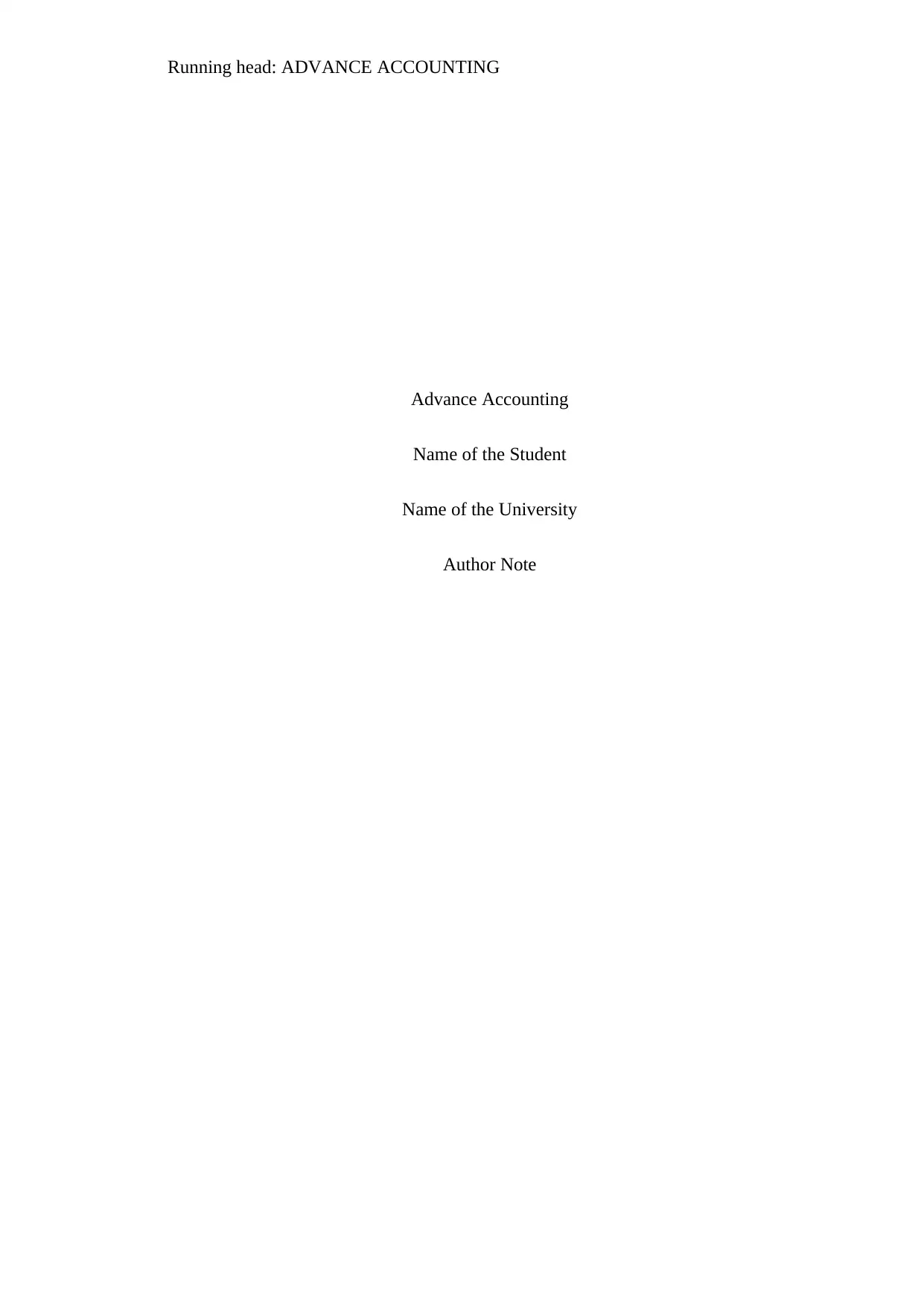
Running head: ADVANCE ACCOUNTING
Advance Accounting
Name of the Student
Name of the University
Author Note
Advance Accounting
Name of the Student
Name of the University
Author Note
Secure Best Marks with AI Grader
Need help grading? Try our AI Grader for instant feedback on your assignments.
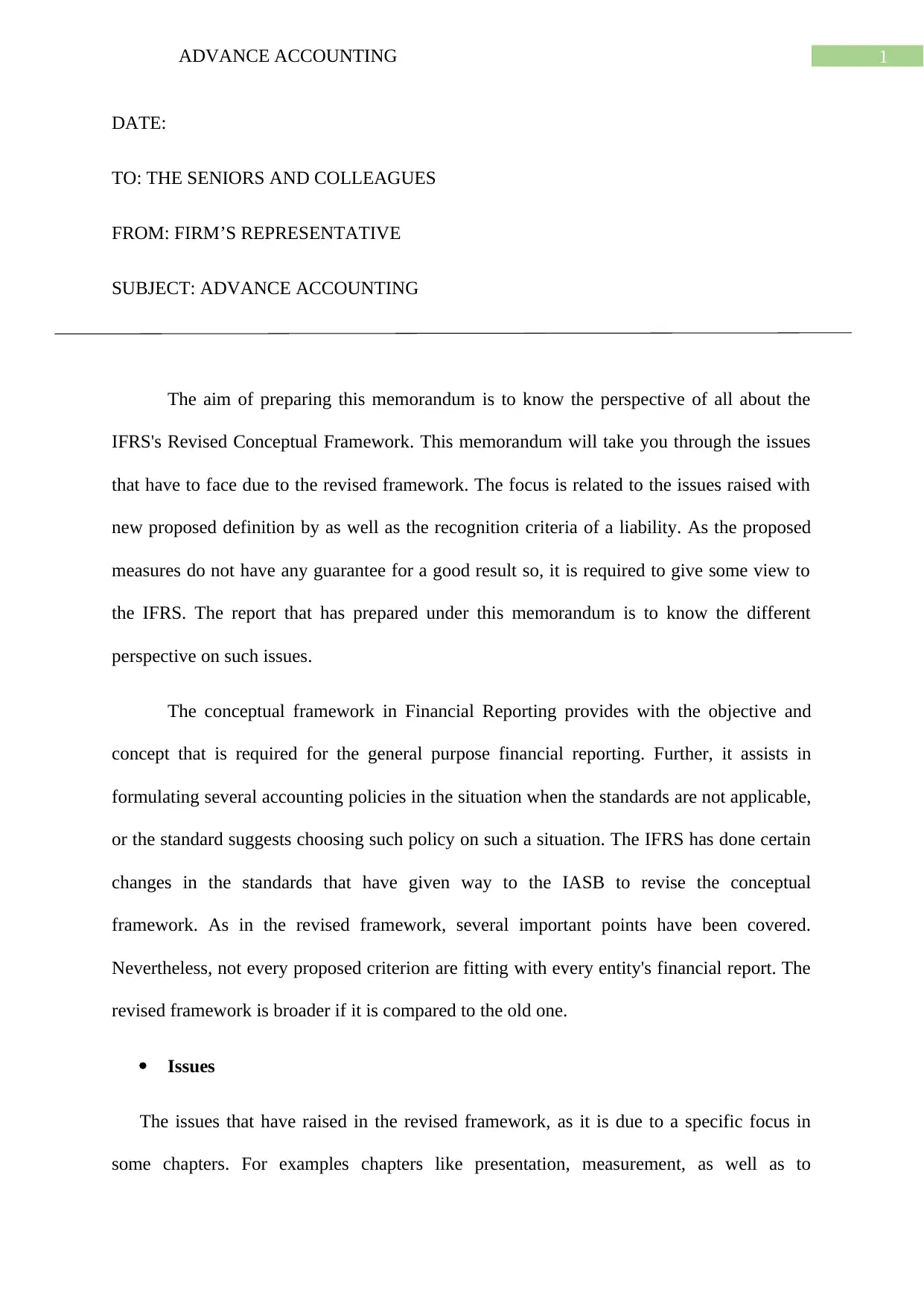
1ADVANCE ACCOUNTING
DATE:
TO: THE SENIORS AND COLLEAGUES
FROM: FIRM’S REPRESENTATIVE
SUBJECT: ADVANCE ACCOUNTING
The aim of preparing this memorandum is to know the perspective of all about the
IFRS's Revised Conceptual Framework. This memorandum will take you through the issues
that have to face due to the revised framework. The focus is related to the issues raised with
new proposed definition by as well as the recognition criteria of a liability. As the proposed
measures do not have any guarantee for a good result so, it is required to give some view to
the IFRS. The report that has prepared under this memorandum is to know the different
perspective on such issues.
The conceptual framework in Financial Reporting provides with the objective and
concept that is required for the general purpose financial reporting. Further, it assists in
formulating several accounting policies in the situation when the standards are not applicable,
or the standard suggests choosing such policy on such a situation. The IFRS has done certain
changes in the standards that have given way to the IASB to revise the conceptual
framework. As in the revised framework, several important points have been covered.
Nevertheless, not every proposed criterion are fitting with every entity's financial report. The
revised framework is broader if it is compared to the old one.
Issues
The issues that have raised in the revised framework, as it is due to a specific focus in
some chapters. For examples chapters like presentation, measurement, as well as to
DATE:
TO: THE SENIORS AND COLLEAGUES
FROM: FIRM’S REPRESENTATIVE
SUBJECT: ADVANCE ACCOUNTING
The aim of preparing this memorandum is to know the perspective of all about the
IFRS's Revised Conceptual Framework. This memorandum will take you through the issues
that have to face due to the revised framework. The focus is related to the issues raised with
new proposed definition by as well as the recognition criteria of a liability. As the proposed
measures do not have any guarantee for a good result so, it is required to give some view to
the IFRS. The report that has prepared under this memorandum is to know the different
perspective on such issues.
The conceptual framework in Financial Reporting provides with the objective and
concept that is required for the general purpose financial reporting. Further, it assists in
formulating several accounting policies in the situation when the standards are not applicable,
or the standard suggests choosing such policy on such a situation. The IFRS has done certain
changes in the standards that have given way to the IASB to revise the conceptual
framework. As in the revised framework, several important points have been covered.
Nevertheless, not every proposed criterion are fitting with every entity's financial report. The
revised framework is broader if it is compared to the old one.
Issues
The issues that have raised in the revised framework, as it is due to a specific focus in
some chapters. For examples chapters like presentation, measurement, as well as to
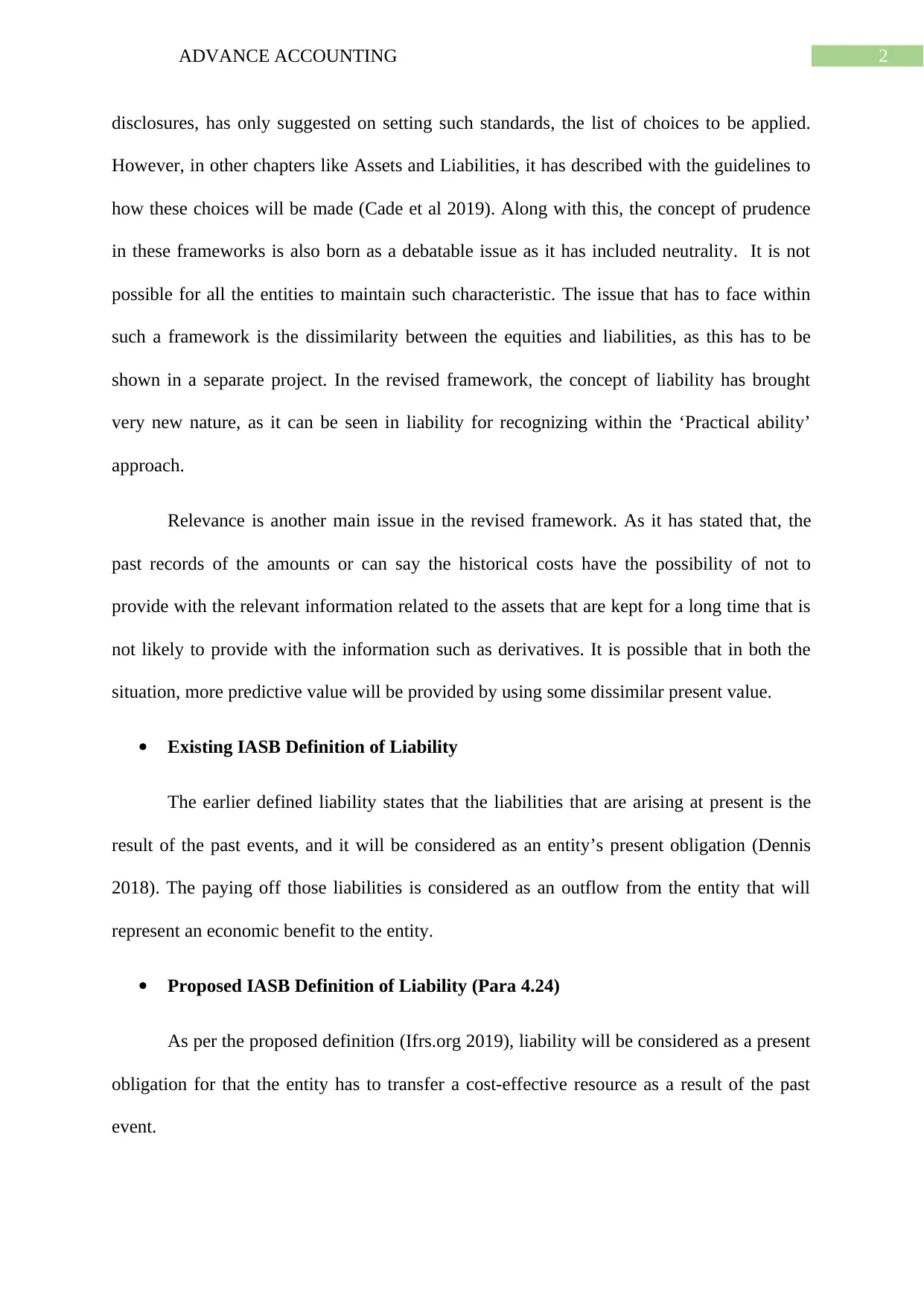
2ADVANCE ACCOUNTING
disclosures, has only suggested on setting such standards, the list of choices to be applied.
However, in other chapters like Assets and Liabilities, it has described with the guidelines to
how these choices will be made (Cade et al 2019). Along with this, the concept of prudence
in these frameworks is also born as a debatable issue as it has included neutrality. It is not
possible for all the entities to maintain such characteristic. The issue that has to face within
such a framework is the dissimilarity between the equities and liabilities, as this has to be
shown in a separate project. In the revised framework, the concept of liability has brought
very new nature, as it can be seen in liability for recognizing within the ‘Practical ability’
approach.
Relevance is another main issue in the revised framework. As it has stated that, the
past records of the amounts or can say the historical costs have the possibility of not to
provide with the relevant information related to the assets that are kept for a long time that is
not likely to provide with the information such as derivatives. It is possible that in both the
situation, more predictive value will be provided by using some dissimilar present value.
Existing IASB Definition of Liability
The earlier defined liability states that the liabilities that are arising at present is the
result of the past events, and it will be considered as an entity’s present obligation (Dennis
2018). The paying off those liabilities is considered as an outflow from the entity that will
represent an economic benefit to the entity.
Proposed IASB Definition of Liability (Para 4.24)
As per the proposed definition (Ifrs.org 2019), liability will be considered as a present
obligation for that the entity has to transfer a cost-effective resource as a result of the past
event.
disclosures, has only suggested on setting such standards, the list of choices to be applied.
However, in other chapters like Assets and Liabilities, it has described with the guidelines to
how these choices will be made (Cade et al 2019). Along with this, the concept of prudence
in these frameworks is also born as a debatable issue as it has included neutrality. It is not
possible for all the entities to maintain such characteristic. The issue that has to face within
such a framework is the dissimilarity between the equities and liabilities, as this has to be
shown in a separate project. In the revised framework, the concept of liability has brought
very new nature, as it can be seen in liability for recognizing within the ‘Practical ability’
approach.
Relevance is another main issue in the revised framework. As it has stated that, the
past records of the amounts or can say the historical costs have the possibility of not to
provide with the relevant information related to the assets that are kept for a long time that is
not likely to provide with the information such as derivatives. It is possible that in both the
situation, more predictive value will be provided by using some dissimilar present value.
Existing IASB Definition of Liability
The earlier defined liability states that the liabilities that are arising at present is the
result of the past events, and it will be considered as an entity’s present obligation (Dennis
2018). The paying off those liabilities is considered as an outflow from the entity that will
represent an economic benefit to the entity.
Proposed IASB Definition of Liability (Para 4.24)
As per the proposed definition (Ifrs.org 2019), liability will be considered as a present
obligation for that the entity has to transfer a cost-effective resource as a result of the past
event.
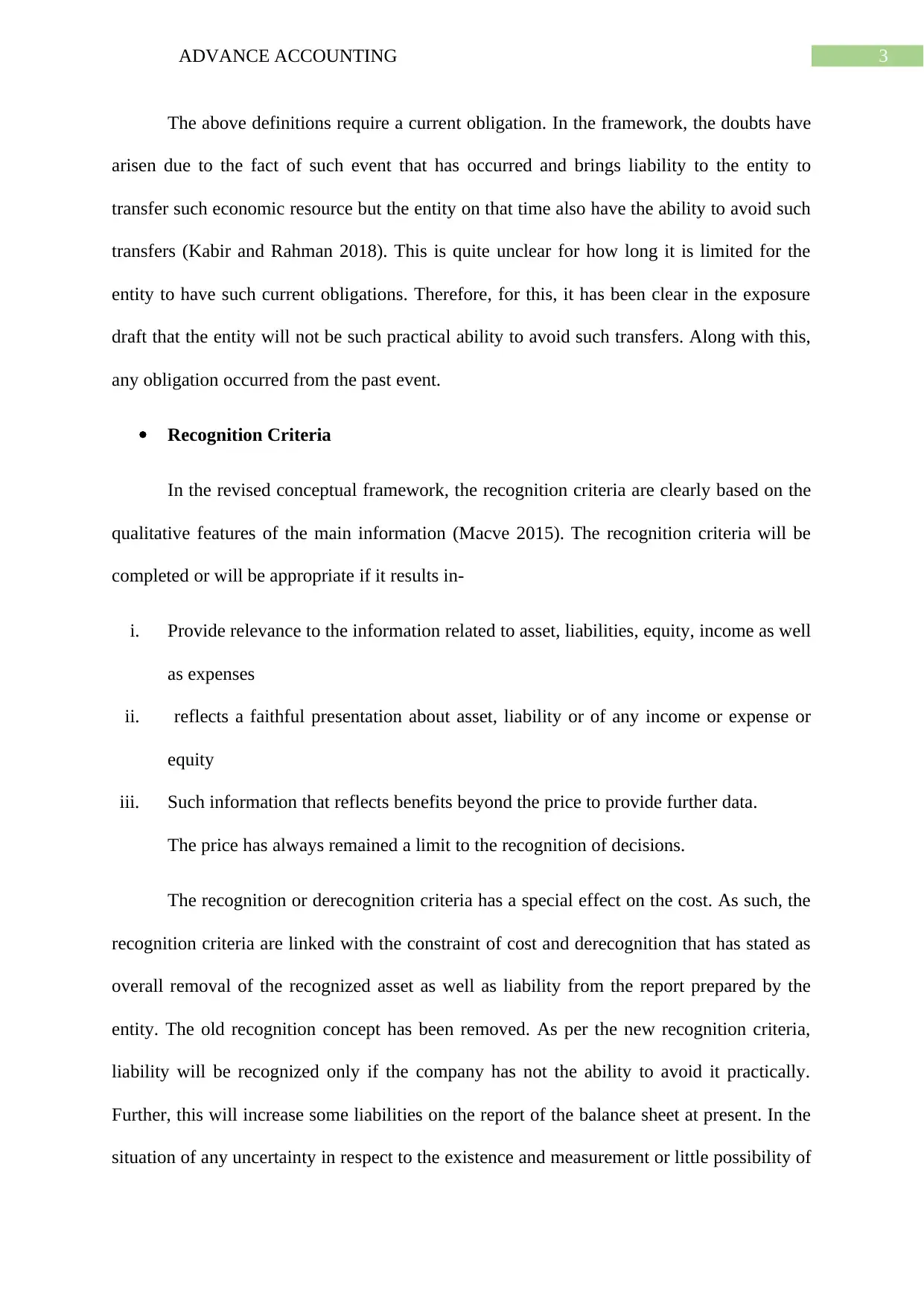
3ADVANCE ACCOUNTING
The above definitions require a current obligation. In the framework, the doubts have
arisen due to the fact of such event that has occurred and brings liability to the entity to
transfer such economic resource but the entity on that time also have the ability to avoid such
transfers (Kabir and Rahman 2018). This is quite unclear for how long it is limited for the
entity to have such current obligations. Therefore, for this, it has been clear in the exposure
draft that the entity will not be such practical ability to avoid such transfers. Along with this,
any obligation occurred from the past event.
Recognition Criteria
In the revised conceptual framework, the recognition criteria are clearly based on the
qualitative features of the main information (Macve 2015). The recognition criteria will be
completed or will be appropriate if it results in-
i. Provide relevance to the information related to asset, liabilities, equity, income as well
as expenses
ii. reflects a faithful presentation about asset, liability or of any income or expense or
equity
iii. Such information that reflects benefits beyond the price to provide further data.
The price has always remained a limit to the recognition of decisions.
The recognition or derecognition criteria has a special effect on the cost. As such, the
recognition criteria are linked with the constraint of cost and derecognition that has stated as
overall removal of the recognized asset as well as liability from the report prepared by the
entity. The old recognition concept has been removed. As per the new recognition criteria,
liability will be recognized only if the company has not the ability to avoid it practically.
Further, this will increase some liabilities on the report of the balance sheet at present. In the
situation of any uncertainty in respect to the existence and measurement or little possibility of
The above definitions require a current obligation. In the framework, the doubts have
arisen due to the fact of such event that has occurred and brings liability to the entity to
transfer such economic resource but the entity on that time also have the ability to avoid such
transfers (Kabir and Rahman 2018). This is quite unclear for how long it is limited for the
entity to have such current obligations. Therefore, for this, it has been clear in the exposure
draft that the entity will not be such practical ability to avoid such transfers. Along with this,
any obligation occurred from the past event.
Recognition Criteria
In the revised conceptual framework, the recognition criteria are clearly based on the
qualitative features of the main information (Macve 2015). The recognition criteria will be
completed or will be appropriate if it results in-
i. Provide relevance to the information related to asset, liabilities, equity, income as well
as expenses
ii. reflects a faithful presentation about asset, liability or of any income or expense or
equity
iii. Such information that reflects benefits beyond the price to provide further data.
The price has always remained a limit to the recognition of decisions.
The recognition or derecognition criteria has a special effect on the cost. As such, the
recognition criteria are linked with the constraint of cost and derecognition that has stated as
overall removal of the recognized asset as well as liability from the report prepared by the
entity. The old recognition concept has been removed. As per the new recognition criteria,
liability will be recognized only if the company has not the ability to avoid it practically.
Further, this will increase some liabilities on the report of the balance sheet at present. In the
situation of any uncertainty in respect to the existence and measurement or little possibility of
Secure Best Marks with AI Grader
Need help grading? Try our AI Grader for instant feedback on your assignments.
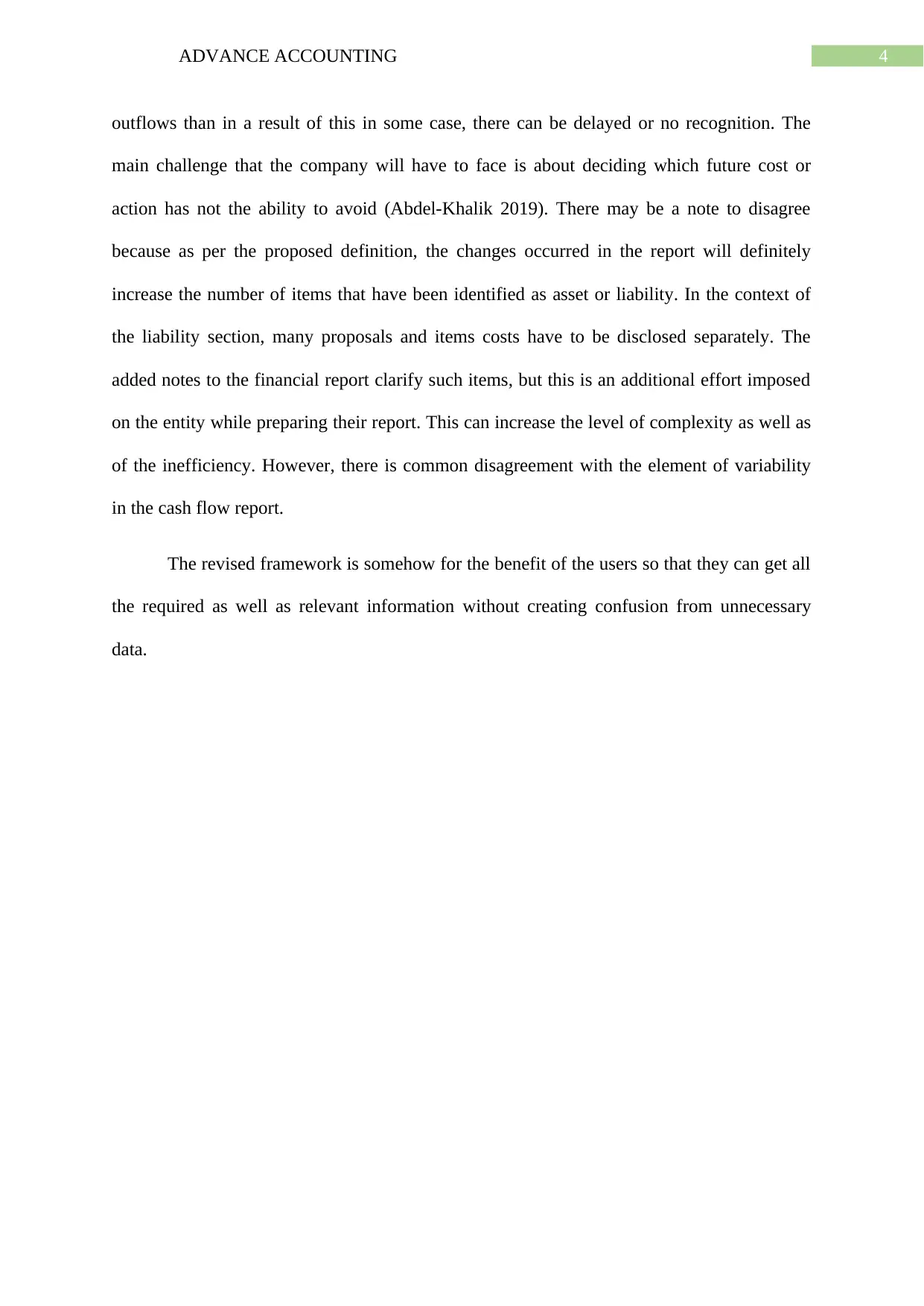
4ADVANCE ACCOUNTING
outflows than in a result of this in some case, there can be delayed or no recognition. The
main challenge that the company will have to face is about deciding which future cost or
action has not the ability to avoid (Abdel-Khalik 2019). There may be a note to disagree
because as per the proposed definition, the changes occurred in the report will definitely
increase the number of items that have been identified as asset or liability. In the context of
the liability section, many proposals and items costs have to be disclosed separately. The
added notes to the financial report clarify such items, but this is an additional effort imposed
on the entity while preparing their report. This can increase the level of complexity as well as
of the inefficiency. However, there is common disagreement with the element of variability
in the cash flow report.
The revised framework is somehow for the benefit of the users so that they can get all
the required as well as relevant information without creating confusion from unnecessary
data.
outflows than in a result of this in some case, there can be delayed or no recognition. The
main challenge that the company will have to face is about deciding which future cost or
action has not the ability to avoid (Abdel-Khalik 2019). There may be a note to disagree
because as per the proposed definition, the changes occurred in the report will definitely
increase the number of items that have been identified as asset or liability. In the context of
the liability section, many proposals and items costs have to be disclosed separately. The
added notes to the financial report clarify such items, but this is an additional effort imposed
on the entity while preparing their report. This can increase the level of complexity as well as
of the inefficiency. However, there is common disagreement with the element of variability
in the cash flow report.
The revised framework is somehow for the benefit of the users so that they can get all
the required as well as relevant information without creating confusion from unnecessary
data.
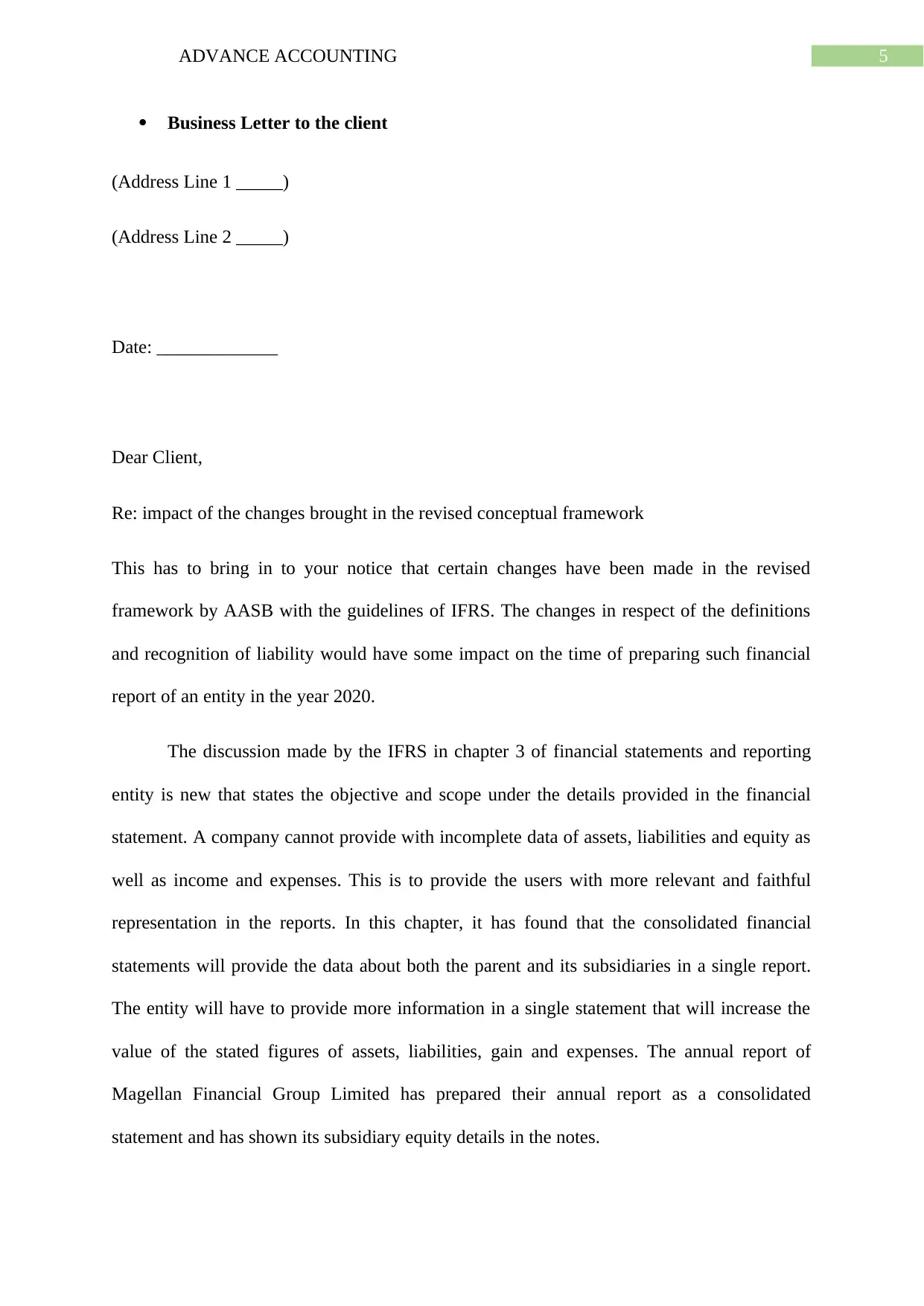
5ADVANCE ACCOUNTING
Business Letter to the client
(Address Line 1 _____)
(Address Line 2 _____)
Date: _____________
Dear Client,
Re: impact of the changes brought in the revised conceptual framework
This has to bring in to your notice that certain changes have been made in the revised
framework by AASB with the guidelines of IFRS. The changes in respect of the definitions
and recognition of liability would have some impact on the time of preparing such financial
report of an entity in the year 2020.
The discussion made by the IFRS in chapter 3 of financial statements and reporting
entity is new that states the objective and scope under the details provided in the financial
statement. A company cannot provide with incomplete data of assets, liabilities and equity as
well as income and expenses. This is to provide the users with more relevant and faithful
representation in the reports. In this chapter, it has found that the consolidated financial
statements will provide the data about both the parent and its subsidiaries in a single report.
The entity will have to provide more information in a single statement that will increase the
value of the stated figures of assets, liabilities, gain and expenses. The annual report of
Magellan Financial Group Limited has prepared their annual report as a consolidated
statement and has shown its subsidiary equity details in the notes.
Business Letter to the client
(Address Line 1 _____)
(Address Line 2 _____)
Date: _____________
Dear Client,
Re: impact of the changes brought in the revised conceptual framework
This has to bring in to your notice that certain changes have been made in the revised
framework by AASB with the guidelines of IFRS. The changes in respect of the definitions
and recognition of liability would have some impact on the time of preparing such financial
report of an entity in the year 2020.
The discussion made by the IFRS in chapter 3 of financial statements and reporting
entity is new that states the objective and scope under the details provided in the financial
statement. A company cannot provide with incomplete data of assets, liabilities and equity as
well as income and expenses. This is to provide the users with more relevant and faithful
representation in the reports. In this chapter, it has found that the consolidated financial
statements will provide the data about both the parent and its subsidiaries in a single report.
The entity will have to provide more information in a single statement that will increase the
value of the stated figures of assets, liabilities, gain and expenses. The annual report of
Magellan Financial Group Limited has prepared their annual report as a consolidated
statement and has shown its subsidiary equity details in the notes.
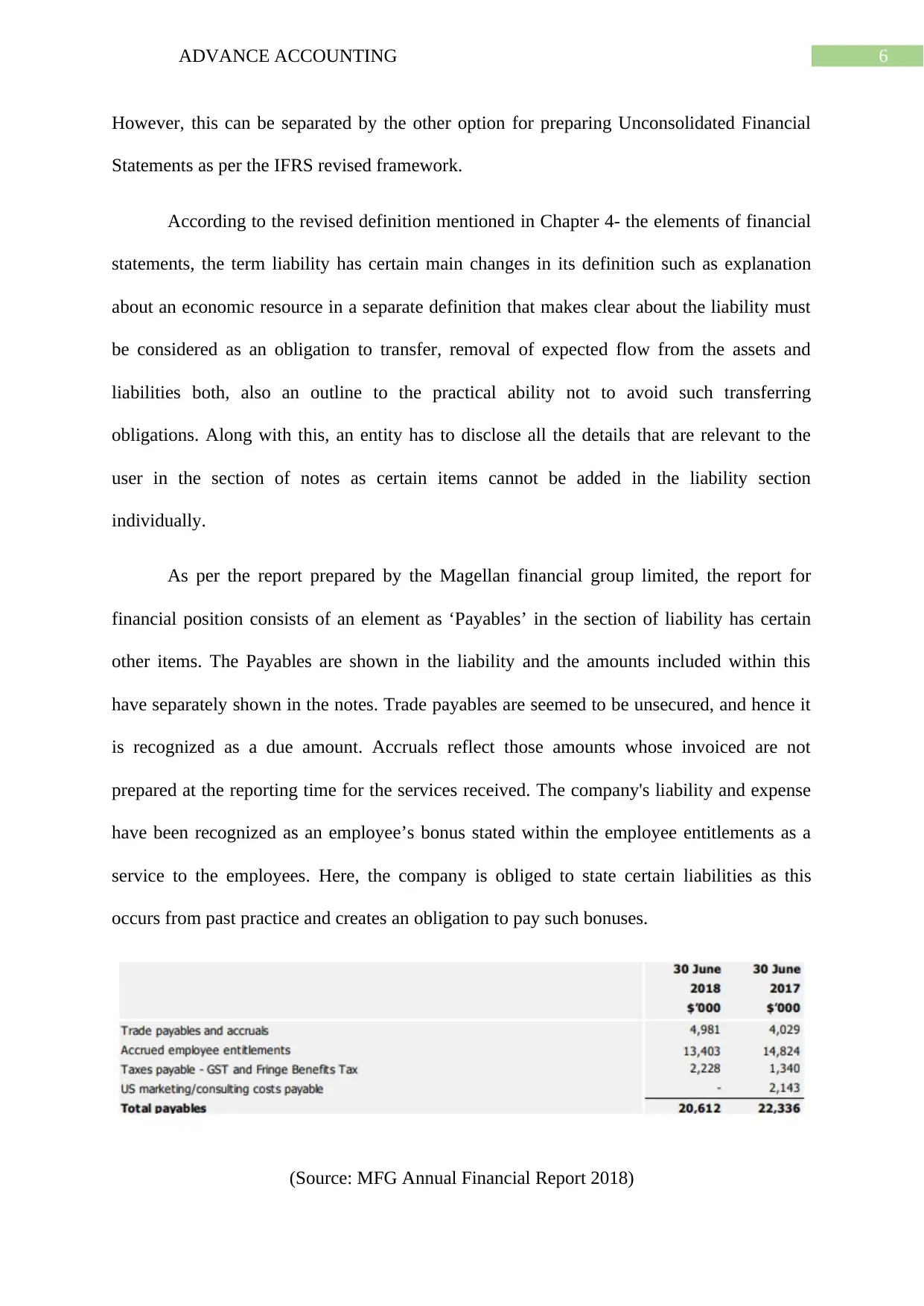
6ADVANCE ACCOUNTING
However, this can be separated by the other option for preparing Unconsolidated Financial
Statements as per the IFRS revised framework.
According to the revised definition mentioned in Chapter 4- the elements of financial
statements, the term liability has certain main changes in its definition such as explanation
about an economic resource in a separate definition that makes clear about the liability must
be considered as an obligation to transfer, removal of expected flow from the assets and
liabilities both, also an outline to the practical ability not to avoid such transferring
obligations. Along with this, an entity has to disclose all the details that are relevant to the
user in the section of notes as certain items cannot be added in the liability section
individually.
As per the report prepared by the Magellan financial group limited, the report for
financial position consists of an element as ‘Payables’ in the section of liability has certain
other items. The Payables are shown in the liability and the amounts included within this
have separately shown in the notes. Trade payables are seemed to be unsecured, and hence it
is recognized as a due amount. Accruals reflect those amounts whose invoiced are not
prepared at the reporting time for the services received. The company's liability and expense
have been recognized as an employee’s bonus stated within the employee entitlements as a
service to the employees. Here, the company is obliged to state certain liabilities as this
occurs from past practice and creates an obligation to pay such bonuses.
(Source: MFG Annual Financial Report 2018)
However, this can be separated by the other option for preparing Unconsolidated Financial
Statements as per the IFRS revised framework.
According to the revised definition mentioned in Chapter 4- the elements of financial
statements, the term liability has certain main changes in its definition such as explanation
about an economic resource in a separate definition that makes clear about the liability must
be considered as an obligation to transfer, removal of expected flow from the assets and
liabilities both, also an outline to the practical ability not to avoid such transferring
obligations. Along with this, an entity has to disclose all the details that are relevant to the
user in the section of notes as certain items cannot be added in the liability section
individually.
As per the report prepared by the Magellan financial group limited, the report for
financial position consists of an element as ‘Payables’ in the section of liability has certain
other items. The Payables are shown in the liability and the amounts included within this
have separately shown in the notes. Trade payables are seemed to be unsecured, and hence it
is recognized as a due amount. Accruals reflect those amounts whose invoiced are not
prepared at the reporting time for the services received. The company's liability and expense
have been recognized as an employee’s bonus stated within the employee entitlements as a
service to the employees. Here, the company is obliged to state certain liabilities as this
occurs from past practice and creates an obligation to pay such bonuses.
(Source: MFG Annual Financial Report 2018)
Paraphrase This Document
Need a fresh take? Get an instant paraphrase of this document with our AI Paraphraser
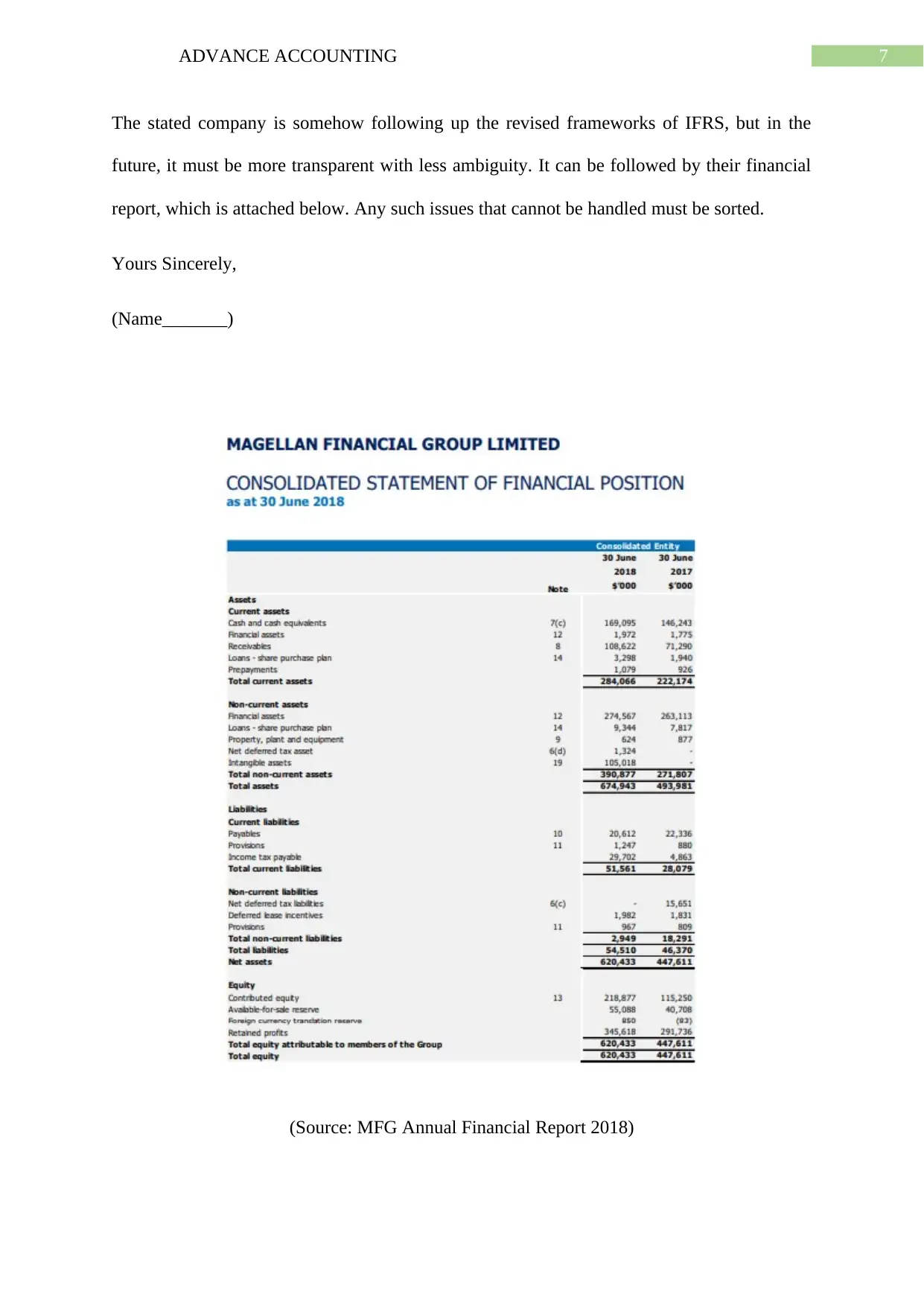
7ADVANCE ACCOUNTING
The stated company is somehow following up the revised frameworks of IFRS, but in the
future, it must be more transparent with less ambiguity. It can be followed by their financial
report, which is attached below. Any such issues that cannot be handled must be sorted.
Yours Sincerely,
(Name_______)
(Source: MFG Annual Financial Report 2018)
The stated company is somehow following up the revised frameworks of IFRS, but in the
future, it must be more transparent with less ambiguity. It can be followed by their financial
report, which is attached below. Any such issues that cannot be handled must be sorted.
Yours Sincerely,
(Name_______)
(Source: MFG Annual Financial Report 2018)
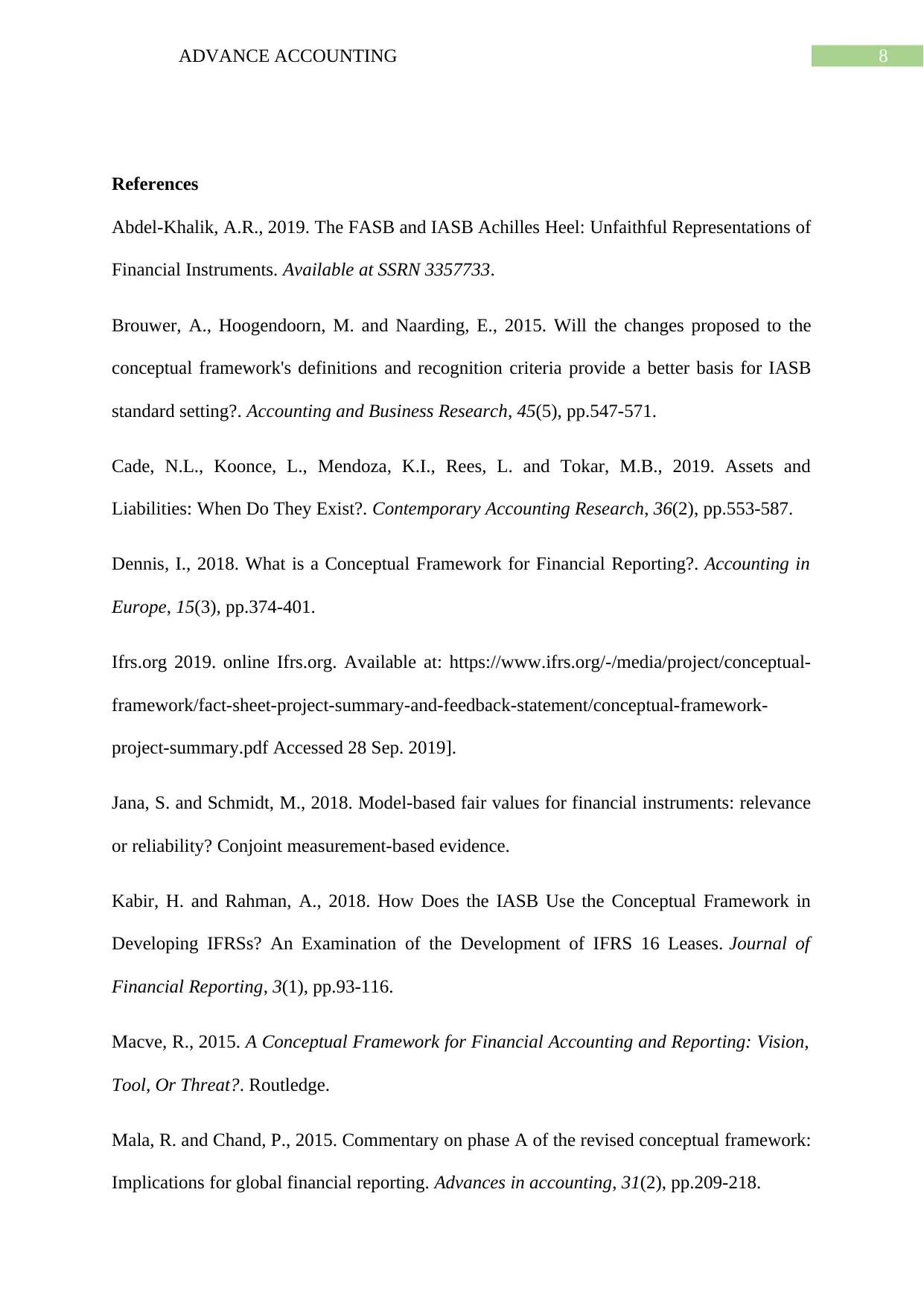
8ADVANCE ACCOUNTING
References
Abdel-Khalik, A.R., 2019. The FASB and IASB Achilles Heel: Unfaithful Representations of
Financial Instruments. Available at SSRN 3357733.
Brouwer, A., Hoogendoorn, M. and Naarding, E., 2015. Will the changes proposed to the
conceptual framework's definitions and recognition criteria provide a better basis for IASB
standard setting?. Accounting and Business Research, 45(5), pp.547-571.
Cade, N.L., Koonce, L., Mendoza, K.I., Rees, L. and Tokar, M.B., 2019. Assets and
Liabilities: When Do They Exist?. Contemporary Accounting Research, 36(2), pp.553-587.
Dennis, I., 2018. What is a Conceptual Framework for Financial Reporting?. Accounting in
Europe, 15(3), pp.374-401.
Ifrs.org 2019. online Ifrs.org. Available at: https://www.ifrs.org/-/media/project/conceptual-
framework/fact-sheet-project-summary-and-feedback-statement/conceptual-framework-
project-summary.pdf Accessed 28 Sep. 2019].
Jana, S. and Schmidt, M., 2018. Model-based fair values for financial instruments: relevance
or reliability? Conjoint measurement-based evidence.
Kabir, H. and Rahman, A., 2018. How Does the IASB Use the Conceptual Framework in
Developing IFRSs? An Examination of the Development of IFRS 16 Leases. Journal of
Financial Reporting, 3(1), pp.93-116.
Macve, R., 2015. A Conceptual Framework for Financial Accounting and Reporting: Vision,
Tool, Or Threat?. Routledge.
Mala, R. and Chand, P., 2015. Commentary on phase A of the revised conceptual framework:
Implications for global financial reporting. Advances in accounting, 31(2), pp.209-218.
References
Abdel-Khalik, A.R., 2019. The FASB and IASB Achilles Heel: Unfaithful Representations of
Financial Instruments. Available at SSRN 3357733.
Brouwer, A., Hoogendoorn, M. and Naarding, E., 2015. Will the changes proposed to the
conceptual framework's definitions and recognition criteria provide a better basis for IASB
standard setting?. Accounting and Business Research, 45(5), pp.547-571.
Cade, N.L., Koonce, L., Mendoza, K.I., Rees, L. and Tokar, M.B., 2019. Assets and
Liabilities: When Do They Exist?. Contemporary Accounting Research, 36(2), pp.553-587.
Dennis, I., 2018. What is a Conceptual Framework for Financial Reporting?. Accounting in
Europe, 15(3), pp.374-401.
Ifrs.org 2019. online Ifrs.org. Available at: https://www.ifrs.org/-/media/project/conceptual-
framework/fact-sheet-project-summary-and-feedback-statement/conceptual-framework-
project-summary.pdf Accessed 28 Sep. 2019].
Jana, S. and Schmidt, M., 2018. Model-based fair values for financial instruments: relevance
or reliability? Conjoint measurement-based evidence.
Kabir, H. and Rahman, A., 2018. How Does the IASB Use the Conceptual Framework in
Developing IFRSs? An Examination of the Development of IFRS 16 Leases. Journal of
Financial Reporting, 3(1), pp.93-116.
Macve, R., 2015. A Conceptual Framework for Financial Accounting and Reporting: Vision,
Tool, Or Threat?. Routledge.
Mala, R. and Chand, P., 2015. Commentary on phase A of the revised conceptual framework:
Implications for global financial reporting. Advances in accounting, 31(2), pp.209-218.
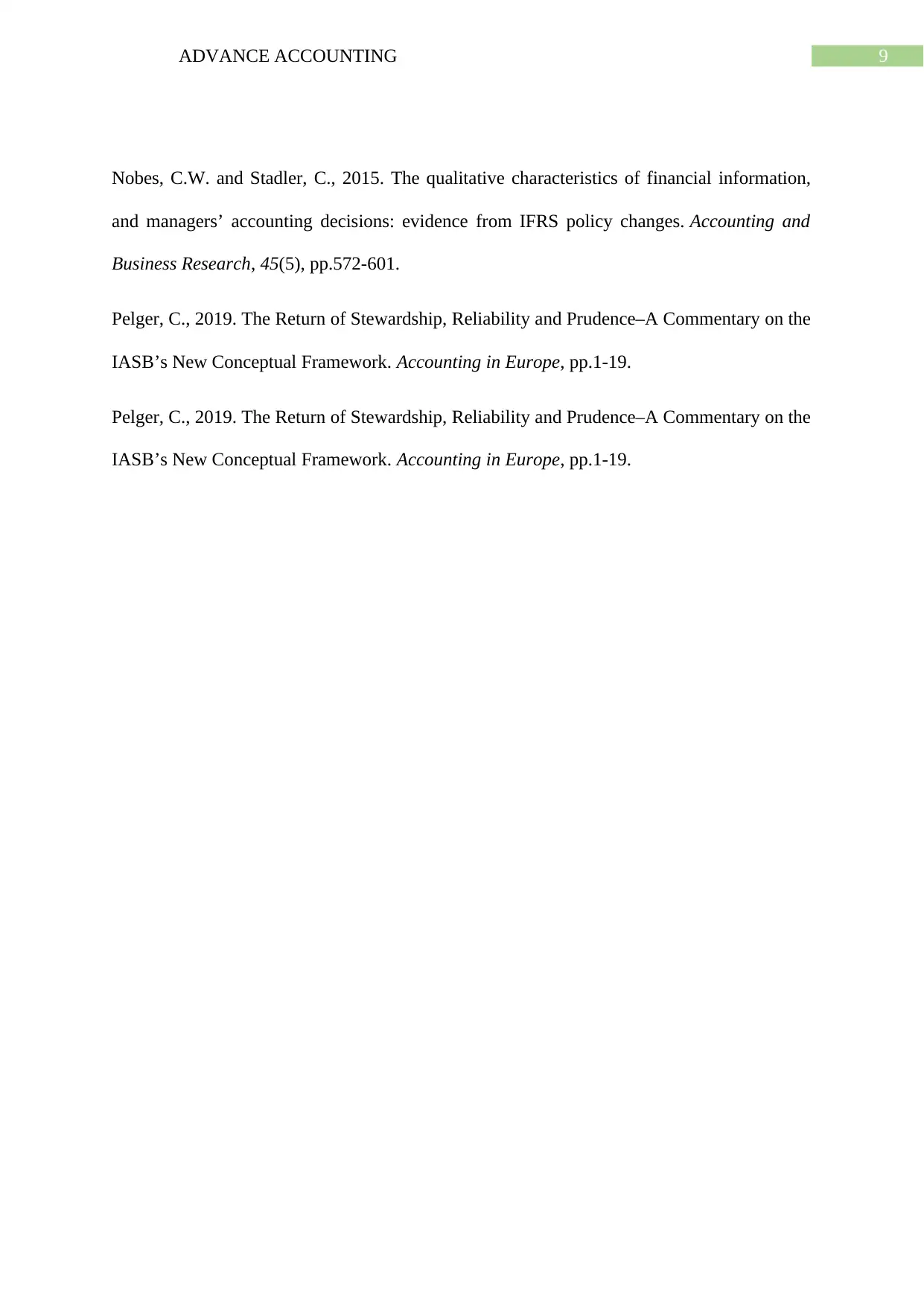
9ADVANCE ACCOUNTING
Nobes, C.W. and Stadler, C., 2015. The qualitative characteristics of financial information,
and managers’ accounting decisions: evidence from IFRS policy changes. Accounting and
Business Research, 45(5), pp.572-601.
Pelger, C., 2019. The Return of Stewardship, Reliability and Prudence–A Commentary on the
IASB’s New Conceptual Framework. Accounting in Europe, pp.1-19.
Pelger, C., 2019. The Return of Stewardship, Reliability and Prudence–A Commentary on the
IASB’s New Conceptual Framework. Accounting in Europe, pp.1-19.
Nobes, C.W. and Stadler, C., 2015. The qualitative characteristics of financial information,
and managers’ accounting decisions: evidence from IFRS policy changes. Accounting and
Business Research, 45(5), pp.572-601.
Pelger, C., 2019. The Return of Stewardship, Reliability and Prudence–A Commentary on the
IASB’s New Conceptual Framework. Accounting in Europe, pp.1-19.
Pelger, C., 2019. The Return of Stewardship, Reliability and Prudence–A Commentary on the
IASB’s New Conceptual Framework. Accounting in Europe, pp.1-19.
Secure Best Marks with AI Grader
Need help grading? Try our AI Grader for instant feedback on your assignments.
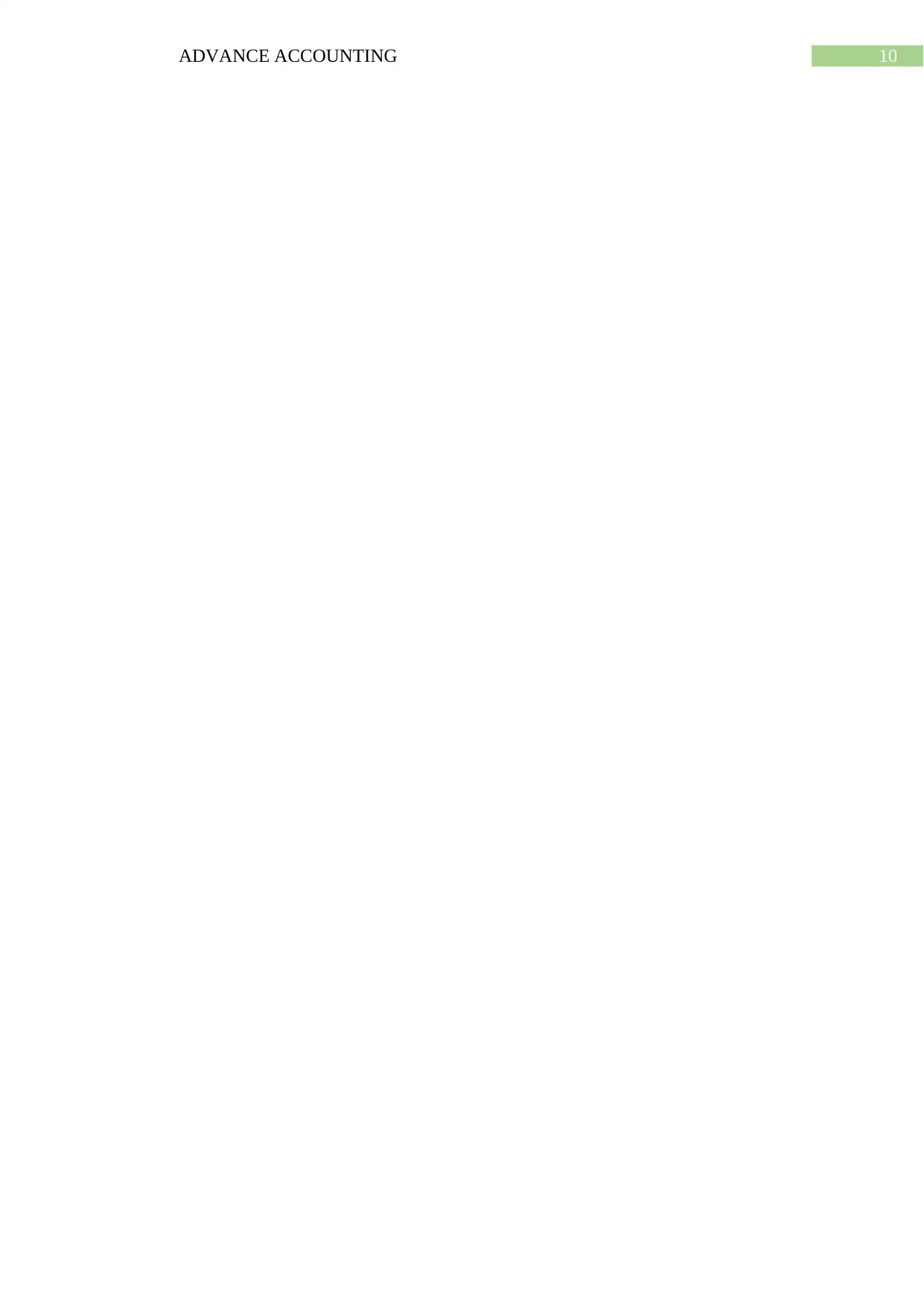
10ADVANCE ACCOUNTING
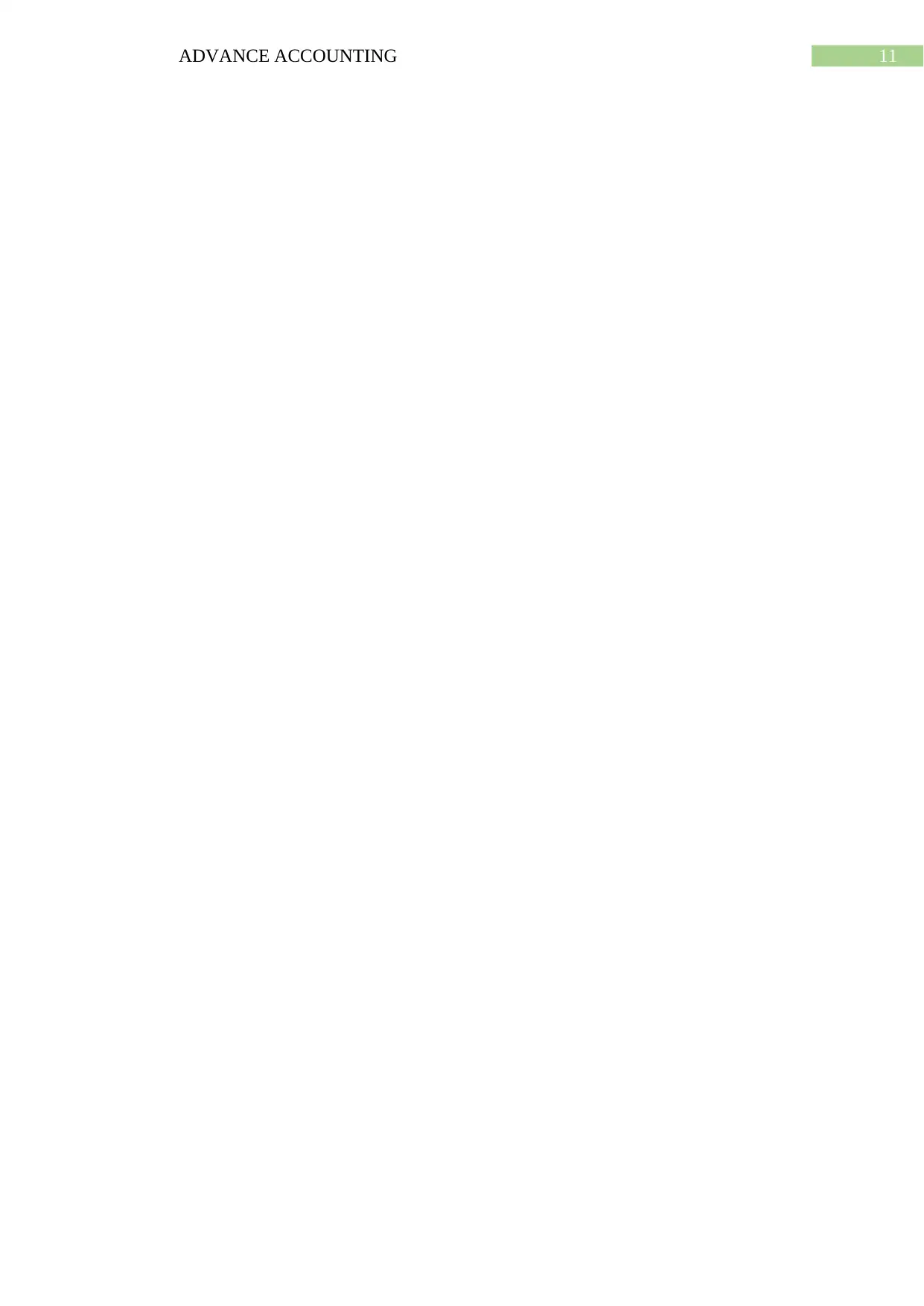
11ADVANCE ACCOUNTING
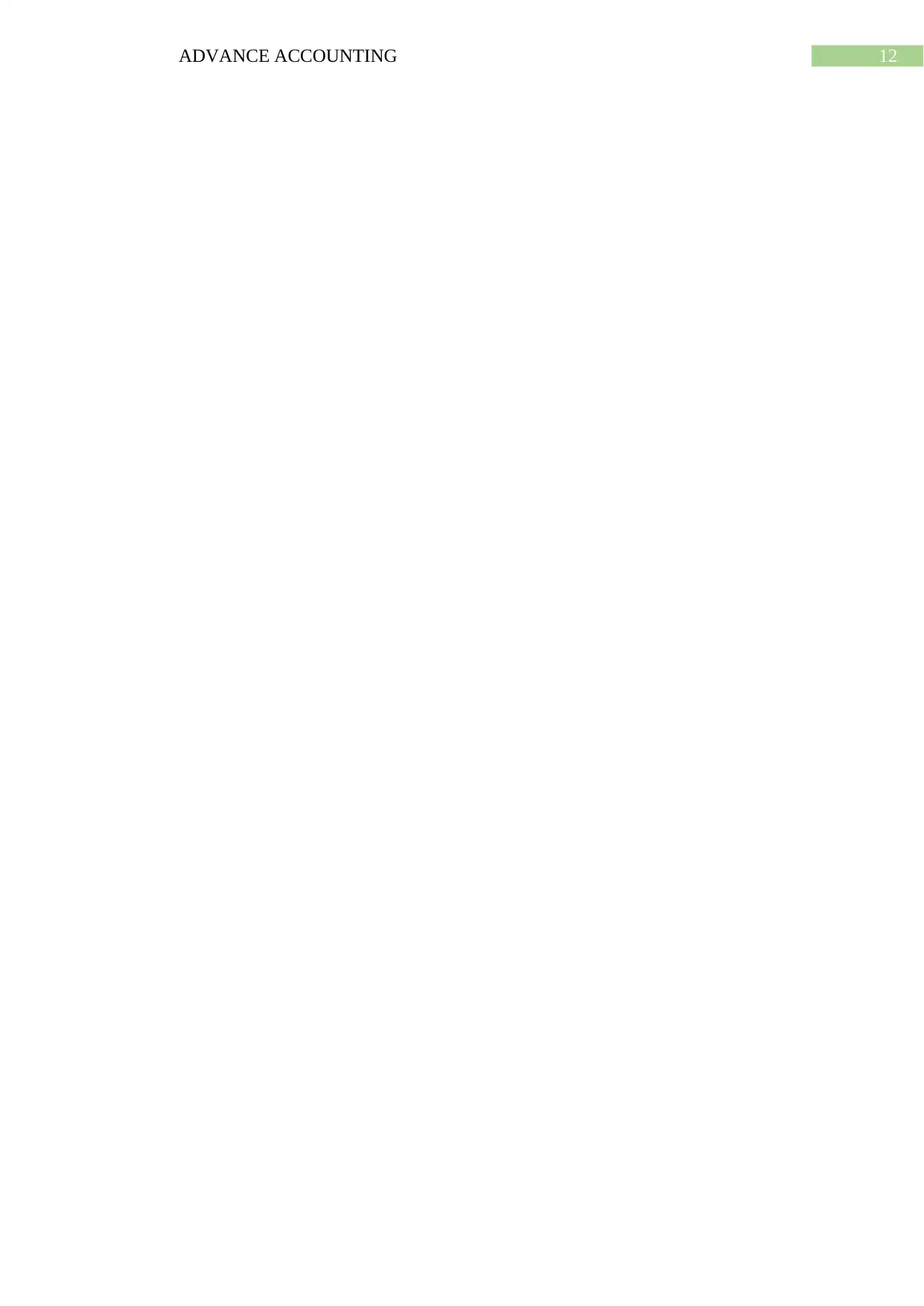
12ADVANCE ACCOUNTING
1 out of 13
Related Documents
Your All-in-One AI-Powered Toolkit for Academic Success.
+13062052269
info@desklib.com
Available 24*7 on WhatsApp / Email
![[object Object]](/_next/static/media/star-bottom.7253800d.svg)
Unlock your academic potential
© 2024 | Zucol Services PVT LTD | All rights reserved.




